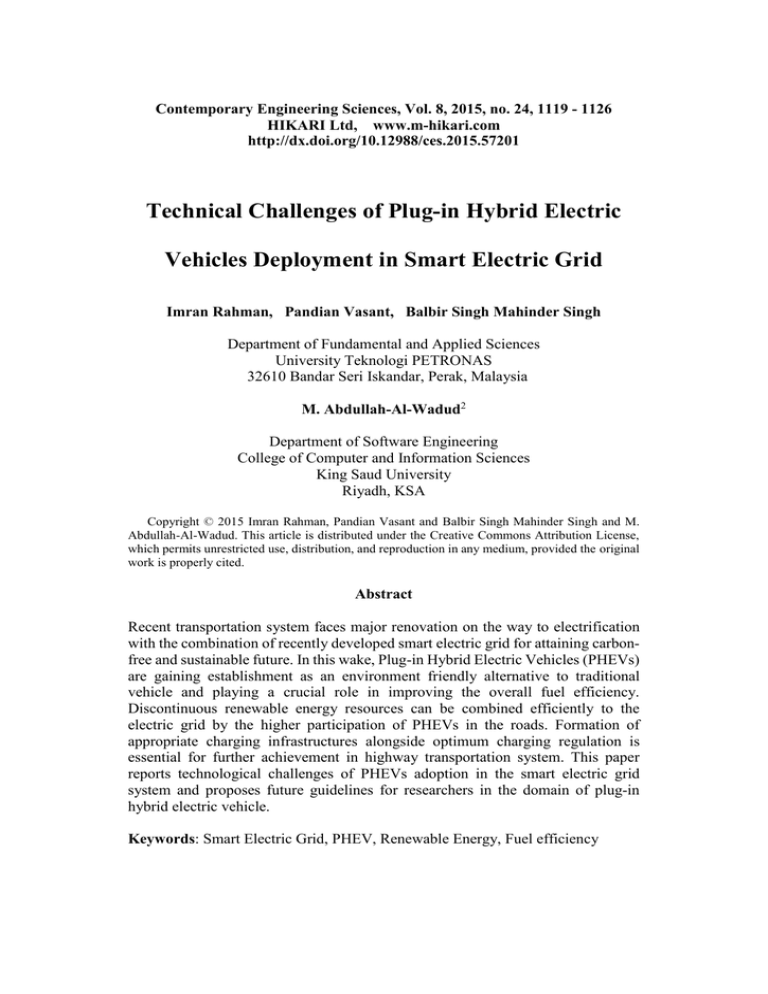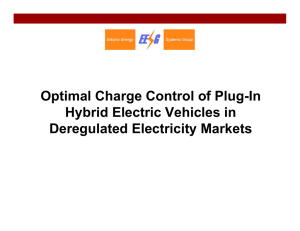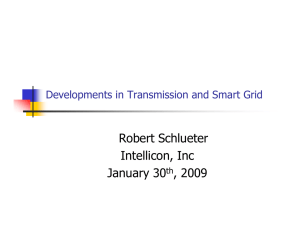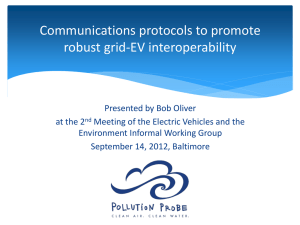Technical Challenges of Plug-in Hybrid Electric Vehicles
advertisement

Contemporary Engineering Sciences, Vol. 8, 2015, no. 24, 1119 - 1126 HIKARI Ltd, www.m-hikari.com http://dx.doi.org/10.12988/ces.2015.57201 Technical Challenges of Plug-in Hybrid Electric Vehicles Deployment in Smart Electric Grid Imran Rahman, Pandian Vasant, Balbir Singh Mahinder Singh Department of Fundamental and Applied Sciences University Teknologi PETRONAS 32610 Bandar Seri Iskandar, Perak, Malaysia M. Abdullah-Al-Wadud2 Department of Software Engineering College of Computer and Information Sciences King Saud University Riyadh, KSA Copyright © 2015 Imran Rahman, Pandian Vasant and Balbir Singh Mahinder Singh and M. Abdullah-Al-Wadud. This article is distributed under the Creative Commons Attribution License, which permits unrestricted use, distribution, and reproduction in any medium, provided the original work is properly cited. Abstract Recent transportation system faces major renovation on the way to electrification with the combination of recently developed smart electric grid for attaining carbonfree and sustainable future. In this wake, Plug-in Hybrid Electric Vehicles (PHEVs) are gaining establishment as an environment friendly alternative to traditional vehicle and playing a crucial role in improving the overall fuel efficiency. Discontinuous renewable energy resources can be combined efficiently to the electric grid by the higher participation of PHEVs in the roads. Formation of appropriate charging infrastructures alongside optimum charging regulation is essential for further achievement in highway transportation system. This paper reports technological challenges of PHEVs adoption in the smart electric grid system and proposes future guidelines for researchers in the domain of plug-in hybrid electric vehicle. Keywords: Smart Electric Grid, PHEV, Renewable Energy, Fuel efficiency 1120 Imran Rahman et al. 1 Introduction Recent technical studies regarding various strategies related to PHEV integrated smart electric grid; such as control and battery charging, vehicle-to-grid (V2G), unit commitment, charging infrastructures, integration of solar and wind energy and demand management prove the electrification of transportation as a rapidly growing field of research. Government and manufacturing industry in developed countries have invested billions of dollars in many partnerships envisioned to decrease the reliance on fossil fuels [1]. Economic feasibility of PHEVs like Chevrolet Volt, Honda, Toyota Prius and other electric vehicles are possibly to pave the way for their large-scale adoption in smart electric grid in the near future. Customers are more likely to convert their fuel-based vehicle into the electricity-driven car because of their growing concern over greenhouse gas emissions and its adverse consequences on the environment. Previous versions of Hybrid Electric Vehicle (HEV) are now replaced by PHEV because of its large storage capability and plugin charging facilities from any charging infrastructures like parking lot near offices, charging station, shopping mall parking spaces, household charging port etc. However, the recent advancement in the concept of V2G [2], which ideally permits bi-directional power flow between the electric vehicle and the power grid hence increases complication and scalability for traditional power system. The concept goal of the smart electric grid along with the future placement of the PHEVs puts frontward various encounters in terms of power grid infrastructure, control and communication [3].In the future, electric-powered vehicles will be plugged into the grid, and their on board energy storage systems will be recharged using clean, renewable electricity. If properly managed, plug-in vehicles could be charged during low demand periods when there is excess capacity on the grid, minimizing the strain on the grid and obviating major generation and transmission infrastructure additions [4]. Without proper maintenance and infrastructure facilities, large number of PHEVs charging will burden the existing grid hence instability of power grid. There comes the adoption capability issues of PHEVs in smart electric grid system. The reminder of the paper is systematized as follows: the nest section will shade light on the definition and characteristics of PHEV, global transportation scenarios and pollution, role of PHEV in smart electric grid. Next sections describe the technological challenges followed by future research directions and conclusion. 2 Worldwide Transportation Situations and Pollution Global climate variation has been getting growing attention lately. However, minimizing emissions of air contaminants [such as nitrogen oxides (NOx), sulphur dioxide (SO2) and Particulate Matter (PM)] is a more crucial problem, predominantly for developing regions. Among all the pollution producing sectors, the road transport sector is one of the major cause for air pollution. For example, road transport accounts for 22.5% and 21.2% of total global NOx and PM emissions in 2000, respectively [5]. More significantly, road vehicle dissipate emissions are focused on city areas and thus causes health problems. So, both national and inter- Technical challenges of plug-in hybrid electric vehicles deployment 1121 national steps towards reducing air pollution from road transport should be given great priority to lessen air pollution and resulting public health damages. As Figure 1 demonstrations, about 96% amount comes from oil, while the rest is from natural gas, biofuels, and electricity. More than 60% of the oil consumed worldwide comes from the transportation sector. So, transport electrification is necessary in order achieve sustainability and shift towards carbon-free technology. Figure 1. 2010 transport energy by source [WEF, 2011] 3 What is PHEV? A hybrid is defined by Society of Automotive Engineers (SAE) [6] as: “A vehicle with two or more energy storage systems both of which must provide propulsion power- either together or independently.” A PHEV has also been defined by SAE [6] as “A hybrid vehicle with the ability to store and use off-board electrical energy in the RESS (Rechargeable Energy Storage System)”. Table 1 illustrates the features of transitional electric vehicle types, including mild and full HEVs, PHEVs-each of which is gradually more electrified and expected to play a progressively larger role toward shifting a portion of the transportation energy burden toward other sources and away from tradition fuel like petroleum. Once the battery is worn-out, the PHEV operates as a conventional hybrid vehicle. From the table it is clear that, PHEV offers unique grid connection facility with medium onboard storage. 1122 Imran Rahman et al. Table 1. Structures of Intermediate Electric Vehicles [7] Electric On-board Grid Linkage Electric Power Electric Storage Mild HEV Low Low No No Full HEV Medium Low No Very limited PHEV Medium Medium Yes Limited Vehicle Type Driving 4 Role of PHEV in Smart Electric Grid PHEVs use the electric power grid to recharge their on-board batteries. Because household charging can overlap with peak demand phases, the probable load on the electric power grid could be noteworthy. Bi-directional communication between the power grid and PHEVs can stabilize the cumulative demand essential for charging by time-shifting demand loads to periods of lower demand, such as during the night. These two-way communications from a utility’s head-end scheme to PHEVs at customer premises require both smart metering and smart charging facilities. For this, smart electric grid is the only solution as it provides bidirectional flow of power between two loads. There are five important aspects of PHEV’s role in smart electric grid. These aspects are described in the next few subsections. A. Charge Scheduling Charge scheduling deals with proper charging management of PHEVs coming to the charging infrastructure. The power demand of smart electric grid varies with the passage of time. If the owners of PHEV charge their on-board electric storage devices (for example, batteries) in uncoordinated pattern, then it will increase the peal load demand. Recently, noteworthy research studies have been conducted to coordinated PHEV charging. A network sensitive linear optimization model was proposed by Richardson et al. [8] for maximizing overall delivered charging power electric vehicles while maintaining thermal and voltage limits. A 2-stages optimization model was developed by Luo et al. [9] to reduce the load fluctuation and pick load. Some researchers suggested three types of coordinated PHEV charging approaches to reduce the overall load factor, power losses, in a distribution Technical challenges of plug-in hybrid electric vehicles deployment 1123 domain. Overall research areas in PHEV charge scheduling are: constructing real time intelligent algorithms for charging, charging control in the grid, game theoretic models for coordinated charging and optimal battery charging operation in smart electric grid environment. B. Integration of Renewable Energy Integration of renewable energy sources is a challenge for upcoming smart grid technologies. Most of the renewable energy sources such as solar and wind rely considerably on factors like weather. For this, energy produced by renewable sources tends to be intermittent in nature and have the characteristics like short time fluctuation. The on-board battery of PHEV plays a significant role in decreasing this fluctuation of renewable energy production [10]. The smart grid concept deals with the uncertainty of renewable energy production by scheduling the PHEVs according to the availability of renewable energy resources. During the pick time of electricity demand, the PHEV can be charged from renewable energy-based charging infrastructure hence optimize power production from the traditional grid. C. Vehicle-to-Grid (V2G) Plug-in Electric vehicles can be linked into tradition power systems and run with different purposes such as dynamic loads by drawing power from the power grid during charging or dynamic energy storage system by feeding power back to the grid. It is worth mentioning that the latter is referred to as V2G [11]. The interaction of PHEVs with a power grid is an attractive research topic which has drawn attention to a number of people in the academia, industry, private and public research centres. The possibility of PHEV to return back the extra power from its on-board battery to the grid is the main concept of V2G. As a result, PHEV can be used for ancillary services, peak load shaving and real-time frequency regulation in smart electric grid condition. Any vehicle need three (03) main features in order to perform V2G operation: Power connection capability to grid system, communication and control devices in order to help grid operators to access PHEV batteries and smart metering system to track the flow of energy. This V2G capability will help the vehicle owner to earn money by selling battery power back to power grid. Various technological steps essential to integrate PHEV into smart electric grid in an effective manner are yet under development phases. Research actions and pilot projects initiatives are already in place to facilitate the V2G idea into reality. 5 Technological Challenges There are several technological challenges for the implementation of PHEV friendly smart electric grid. As the traditional power grid serves for general industrial and household purpose only, this PHEV acts as an extra load to the grid system hence disturb the power system stability. Proper PHEV load management is 1124 Imran Rahman et al. a challenge for the researchers and success of this vehicle is substantially depends upon this. Moreover, Artificial Intelligence (AI)-based methods like neural network, fuzzy logic, and metaheuristics are needed to be applied for solving complicated uncertain problems of PHEV in smart grid. The knowledgeable researcher should capable to select the suitable algorithm depending on the problem. Multi-objective optimization techniques can also be applied for a multicriteria optimization problems [12]. Optimization methods can only be applied by creating mathematical objective function with system constraints. Cost and life cycle of PHEV batteries, complications of chargers are two important challenges as far as the PHEV storage and charging system is concern. Lack of proper and adequate charging infrastructure is another issue regarding PHEV compared to typical fuel station. As a result, uncertainty in energy management for the driver named as ‘Range anxiety’ develops which restricts the conventional vehicle owner to switch their vehicle to PHEV ones. Selecting appropriate place for fast charging station can decrease this range anxiety. Now-adays, Inductive charging or contactless power transfer of PHEV is gaining much attention because of its convenience for the user to charge their vehicles magnetically. It has some disadvantages such as manufacturing complication, low efficiency, bulk size and cost. The price of PHEV is another important issue. Due to complex battery technology, the price is still high enough compared to traditional vehicle. 6 Future Research Directions This paragraph suggests future directions of techniques and procedures for PHEV in smart electric grid. This specific field of research is comparatively new and possible future outlooks have to be highlighted, so that new techniques can be comprehended. (i) Charging infrastructure efficiency is a key performance indicator for successful penetration of PHEV in smart electric grid. Different sensors are needed for charging control and automatic detection of State-of-Charge (SoC). So, researches should design and construct sensors for this purpose. (ii) Computational intelligence based techniques should be applied to solve numerous mathematical optimization problems in PHEV integrated smart electrical network [13-14]. (iii) Some of the research fields like smart parking lot design and market participation strategy previously got little attention. So, researchers should pay attention to this issue. (iv) PHEV business model is another field of study where very less research work has done. Without proper business model it is impossible to implement several techniques within smart electric grid environment. (v) Two promising technologies are PHEV and the smart building. The combination of these two developing technologies embraces great futures in boosting the reliability of power supply, comfort management and building energy flexibility. Technical challenges of plug-in hybrid electric vehicles deployment 1125 The overall aim of smart building is to maximize the customer satisfaction with lowest power consumption. 7 Conclusion An ever increasing number of PHEVs will drastically change the age old views of the control and transportation industries, the social atmosphere, and the commercial world. The transport electrification carries both opportunities and challenges to existing critical infrastructures. There is still significant amount of investigation needed before the full version of the electrification of transportation comes into reality. In this paper, various challenges and adoption issues of PHEV in smart electric grid are highlighted in order to raise awareness among the researchers in the field of renewable energy resources. The future research directions section also suggests some technical measures necessary to be implemented in order to facilitate the upcoming PHEVs fleet into the road transport network. Acknowledgements. This work was supported by Graduate Assistantship (GA) scheme from Universiti Teknologi PETRONAS (UTP). Authors would also like to thank Department of Fundamental and Applied Sciences (DFAS) for the encouragement and research facilities. References [1] M. Contestabile, G. J. Offer, R. Slade, F. Jaeger, and M. Thoennes, Battery Electric Vehicles, Hydrogen Fuel Cells and Biofuels. Which Will Be the Winner?, Energy & Environmental Science, 4 (2011), 3754 -72. http://dx.doi.org/10.1039/c1ee01804c [2] I. Rahman, P.M. Vasant, B.S.M. Singh, and M. Abdullah–Al–Wadud, Optimisation of PHEV/EV charging infrastructures: a review, International Journal of Energy Technology and Policy, 10 (2014), no. 3, 280 - 296. http://dx.doi.org/10.1504/ijetp.2014.066878 [3] S. Li, K. Bao, X. Fu, and H. Zheng, Energy Management and Control of Electric Vehicle Charging Station, Electric Power Components and Systems, 42 (2014), 339 - 347. http://dx.doi.org/10.1080/15325008.2013.837120 [4] K. D. Maniya, and M. G. Bhatt, A selection of optimal electrical energy equipment using integrated multi criteria decision making methodology, International Journal of Energy Optimization and Engineering (IJEOE), 2 (2013), no. 1, 101 - 116. http://dx.doi.org/10.4018/ijeoe.2013010107 [5] T. Takayuki, Global scenarios of air pollutant emissions from road transport 1126 Imran Rahman et al. through to 2050, International journal of environmental research and public health, 8 (2011), 3032 - 3062. http://dx.doi.org/10.3390/ijerph8073032 [6] M. Rawson, S. Kateley, SAE Technical Paper (California Energy Commission, 1998). [7] Y. Murat and P. T. Krein, Review of battery charger topologies, charging power levels, and infrastructure for plug-in electric and hybrid vehicles, IEEE Transactions on Power Electronics, 28 (2013), no. 5, 2151 - 2169. http://dx.doi.org/10.1109/tpel.2012.2212917 [8] D. B. Richardson, Electric Vehicles and the Electric Grid: A Review of Modeling Approaches, Impacts, and Renewable Energy Integration, Renewable and Sustainable Energy Reviews, 19 (2013), 247 - 254. http://dx.doi.org/10.1016/j.rser.2012.11.042 [9] L. Zhuowei, Z. Hu, Y. Song, Z. Xu, and H. Lu, Optimal coordination of plugin electric vehicles in power grids with cost-benefit analysis—Part I: Enabling techniques, IEEE Transactions on Power Systems, 28 (2013), no. 4, 3546 3555. http://dx.doi.org/10.1109/tpwrs.2013.2262318 [10] I. Rahman, P.M. Vasant, B.S.M. Singh, and M. Abdullah–Al–Wadud, Intelligent Energy Allocation Strategy for PHEV Charging Station Using Gravitational Search Algorithm, AIP Conference Proceedings, 1621 (2014), 52 - 59. http://dx.doi.org/10.1063/1.4898445 [11] A. R. Hota, M. Juvvanapudi, and P. Bajpai, Issues and Solution Approaches in PHEV Integration to the Smart Grid, Renewable and Sustainable Energy Reviews, 30 (2014), 217 - 229. http://dx.doi.org/10.1016/j.rser.2013.10.008 [12] M. R. Jabbarpour, H. Malakooti, R. M. Noor, N. B. Annur, and N. Khamis, Ant colony optimisation for vehicle traffic systems: applications and challenges, International Journal of Bio-Inspired Computation, 6 (2014), no. 1, 32 - 56. http://dx.doi.org/10.1504/ijbic.2014.059970 [13] X. S. Yang, and Z. Cui, Bio-inspired computation: success and challenges of IJBIC, International Journal of Bio-Inspired Computation, 6 (2014), no. 1, 1 -6. http://dx.doi.org/10.1504/ijbic.2014.059969 [14] S. Mehdi, and H. M. Hosseini, Evaluation of Fuzzy Linear Programming Application in Energy Models, International Journal of Energy Optimization and Engineering (IJEOE), 2 (2013), no. 1, 50 - 59. http://dx.doi.org/10.4018/ijeoe.2013010104 Received: July 24, 2015; Published: October 16, 2015


